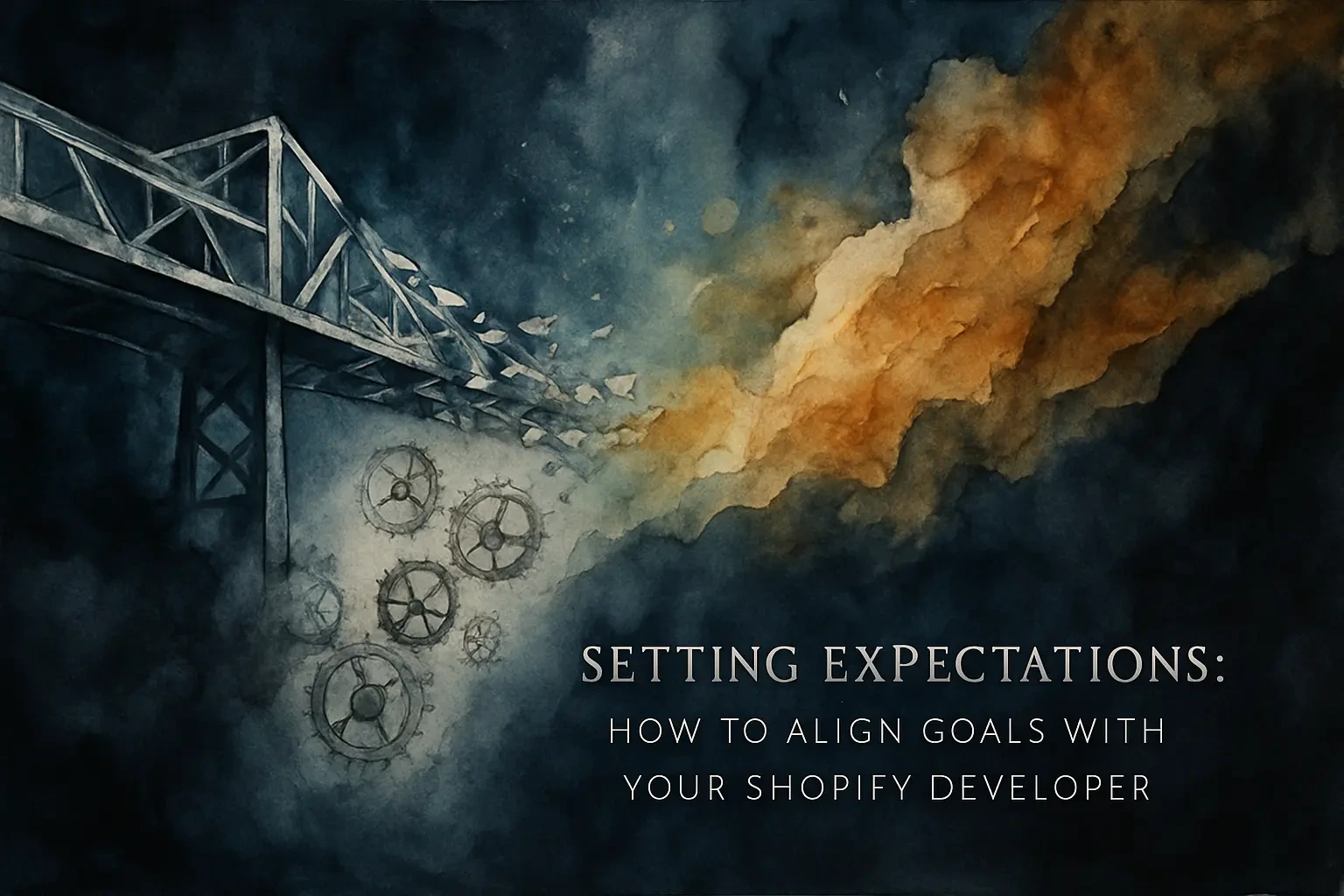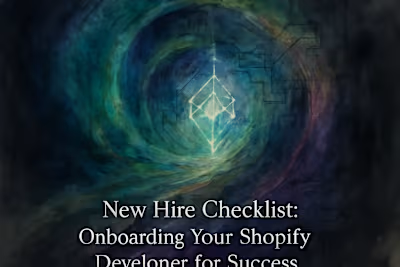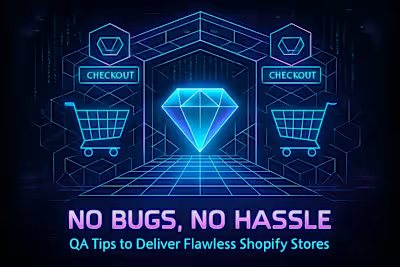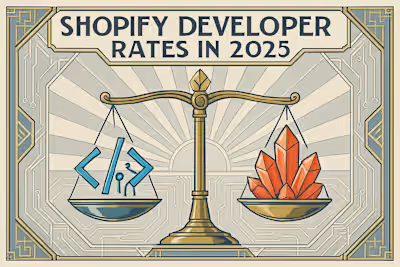Setting Expectations: How to Align Goals with Your Shopify Developer

Setting Expectations: How to Align Goals with Your Shopify Developer
Defining Project Scope and Deliverables
Write a Detailed Project Brief
Use User Stories to Define Features
Agree on What's "Out of Scope"
Establishing Timelines and Milestones
Break Down the Project into Phases
Set Clear Deadlines for Each Milestone
Clarifying Communication Protocols
Choose Your Communication Channels
Set a Cadence for Updates and Meetings
Defining Success with Key Performance Indicators (KPIs)
Identify Business-Centric KPIs
Track Technical Performance
Conclusion
References
Setting Expectations: How to Align Goals with Your Shopify Developer
Hiring a talented Shopify developer is only half the battle; the key to project success lies in crystal-clear communication and perfectly aligned expectations. Misalignment can lead to scope creep, missed deadlines, and a final product that doesn't meet your vision. This guide will walk you through creating a framework for success, starting with a solid onboarding process. Furthermore, effective communication is paramount, especially for non-tech founders.
Think of your Shopify developer relationship like building a house. You wouldn't just tell a contractor "build me something nice" and walk away. You'd share blueprints, discuss materials, and check progress regularly. The same principle applies here. Setting clear expectations from day one saves you from costly misunderstandings down the road.
Defining Project Scope and Deliverables
The first step is to translate your business needs into concrete, actionable requirements. A vague goal like "improve the website" is not enough. You must clearly define what needs to be built and what the end result should look like.
I've seen too many projects fail because business owners assume developers can read their minds. They can't. Your developer needs specifics to turn your vision into reality. This means getting granular about features, functionality, and the problems you're trying to solve.
Start by asking yourself: What specific business problems am I trying to solve? Are customers abandoning carts because checkout is confusing? Is your site slow on mobile devices? Pin down the exact pain points. Then work backward to identify the features that address these issues.
Write a Detailed Project Brief
Create a comprehensive document that outlines the project's purpose, background, target audience, and specific features. Include mockups or wireframes to provide visual clarity.
Your project brief should tell a story. Start with the current situation and problems. Then paint a picture of the desired future state. Include real examples from your business. If customers complain about finding products, show screenshots of the current navigation and sketch out how you'd like it improved.
Don't worry about making it perfect. Even rough sketches help developers understand your vision. Use tools like Figma or even hand-drawn mockups. The goal is clarity, not artistic perfection. Include details like:
Current conversion rates and where you want them to be
Specific customer complaints you're addressing
Competitor features you admire
Your brand guidelines and aesthetic preferences
Technical requirements like integrations with other tools
Remember to include context about your business model. A subscription box service has different needs than a one-time purchase store. Your developer needs this background to make smart technical decisions.
Use User Stories to Define Features
Frame requirements from a user's perspective (e.g., "As a customer, I want to be able to filter products by color so I can find what I'm looking for faster"). This helps the developer understand the "why" behind each feature.
User stories force you to think like your customers. They transform abstract features into concrete benefits. Instead of saying "add product filters," you're explaining the human need behind the request.
Here's how to write effective user stories:
Start with the user type. Are they first-time visitors? Returning customers? Wholesale buyers? Each group has different needs.
Then describe what they want to do. Be specific about the action and the desired outcome. "As a returning customer, I want to reorder previous purchases quickly so I can save time shopping for regular items."
Finally, explain the benefit. This helps your developer understand priority and make smart trade-offs if needed. The more context you provide, the better solutions they can suggest.
Good user stories also reveal dependencies. If customers want to save favorite products, they'll need accounts. If they need accounts, you'll need a login system. This thinking helps identify the full scope of work.
Agree on What's "Out of Scope"
Clearly state what the project will not include. This prevents "scope creep" where new features are continuously added, derailing timelines and budgets.
Scope creep is the silent killer of projects. It starts innocently. "While you're at it, could you just add this one small thing?" But those small things add up fast. Soon your two-week project stretches to two months.
Be explicit about boundaries. If you're redesigning product pages, specify that blog pages aren't included. If you're adding a size guide, clarify that you're not rebuilding the entire product information architecture.
Create a "parking lot" document for future ideas. When inspiration strikes mid-project, add it there instead of the current scope. This acknowledges good ideas without derailing current work. You can tackle these in phase two.
Also define what constitutes a change request versus a clarification. Changing button color might be a clarification. Adding a whole new feature is definitely a change request. Set expectations about how changes affect timeline and budget.
Establishing Timelines and Milestones
With a clear scope, you can work with your developer to create a realistic timeline. Breaking the project into smaller milestones makes it more manageable and easier to track progress.
Realistic timelines require honest conversations. Your developer needs to factor in complexity, testing, and inevitable surprises. You need to consider your availability for feedback and approvals.
Don't fall into the trap of arbitrary deadlines. "I need this by Black Friday" only works if you're starting with enough lead time. Work backward from critical dates, but be prepared to adjust scope if time is tight.
Break Down the Project into Phases
Divide the project into logical phases (e.g., Phase 1: Homepage Redesign, Phase 2: Product Page Optimization). This allows for iterative development and feedback.
Phased approaches reduce risk and improve outcomes. Instead of waiting months to see anything, you get working pieces along the way. This lets you test assumptions and adjust course if needed.
Think about dependencies when planning phases. You might want to update product pages first if that's where most sales happen. Or start with the homepage if you're launching a rebrand. Let business priorities drive the sequence.
Each phase should deliver something usable. Phase 1 might be a working homepage with basic functionality. Phase 2 adds advanced features. This way, you could launch after any phase if needed. It's like building a minimum viable product, then enhancing it.
Build in buffer time between phases. This allows for testing, gathering user feedback, and planning adjustments. Real user data often reveals surprises. Maybe that fancy animation you loved actually hurts conversions. Better to discover this early.
Set Clear Deadlines for Each Milestone
Assign specific deadlines to each phase or key deliverable. This creates accountability and keeps the project moving forward. Use project management tools to visualize the timeline.
Deadlines should be specific and measurable. "Homepage complete" is vague. "Homepage design approved and development finished, ready for testing" is clear. Define what "done" means for each milestone.
Build in dependencies explicitly. If you need to provide product photography by week 2, put it on the timeline. If your developer needs API credentials from a third-party service, schedule it. Missing dependencies cause more delays than technical challenges.
Use visual tools to track progress. Gantt charts show how tasks relate to each other. Kanban boards reveal bottlenecks. Choose tools that work for your team. The best system is one everyone actually uses.
Regular check-ins keep projects on track. Don't wait until a deadline to discover problems. Weekly status updates reveal issues while there's time to address them. Ask specific questions: What was completed this week? What's planned for next week? Any blockers?
Clarifying Communication Protocols
How, when, and where you communicate is just as important as what you communicate. Establishing clear protocols from the start prevents misunderstandings and ensures everyone stays informed.
Communication breakdowns cause more project failures than technical issues. You might assume your developer saw that important email. They might assume you approved that design change. Clear protocols eliminate these assumptions.
Different types of communication need different channels. Quick questions work great in Slack. Detailed feedback needs a more permanent home. Important decisions should be documented somewhere searchable.
Choose Your Communication Channels
Decide on primary tools for different types of communication. For example, use Slack for quick questions, Asana for task-specific comments, and email for formal updates.
Match the tool to the purpose. Real-time chat works for quick clarifications but important decisions get lost in the stream. Project management tools keep discussions tied to specific tasks. Email creates a searchable record for contracts and formal approvals.
Set response time expectations for each channel. Slack might be same-day response. Email could be 24-48 hours. Urgent issues need a phone call. Clear expectations prevent frustration on both sides.
Centralize important information. Create a shared document with project goals, timelines, and key decisions. Update it regularly. This becomes the single source of truth when memories differ about what was agreed.
Be mindful of time zones if working with remote developers. Schedule messages to arrive during their working hours. Use tools that show availability. Respect boundaries to maintain a healthy working relationship.
Set a Cadence for Updates and Meetings
Agree on a schedule for regular check-ins, whether it's a daily asynchronous update or a weekly video call. This ensures consistent communication without causing meeting fatigue.
Find the sweet spot between staying informed and micromanaging. Daily standups work for intense development sprints. Weekly check-ins suit longer projects. The right cadence depends on project complexity and your involvement level.
Asynchronous updates respect everyone's time. Your developer posts progress at day's end. You review and respond when convenient. This works especially well across time zones. Tools like Loom let developers share video walkthroughs without scheduling calls.
Make meetings productive with clear agendas. Share discussion topics in advance. Keep calls focused on decisions and problem-solving. Save status updates for written communication. End each meeting with clear next steps and owners.
Document decisions immediately. Memory fades and details blur. Send a quick recap after each call highlighting key decisions and action items. This prevents the "I thought we agreed on X" conversations later.
Defining Success with Key Performance Indicators (KPIs)
How will you know if the project is a success? Define measurable KPIs before the project begins to objectively evaluate the outcome.
Success means different things to different people. Your developer might focus on clean code and fast load times. You care about sales and customer satisfaction. Define success metrics upfront to align these perspectives.
KPIs should connect to business goals. If you're investing in a site redesign to increase sales, measure conversion rates. If you want to reduce support tickets, track user task completion rates. Make the connection explicit.
Identify Business-Centric KPIs
Focus on metrics that matter to your business, such as conversion rate, average order value, or site speed. These are the ultimate measures of the project's impact.
Start with your primary business goal. Are you trying to increase revenue? Reduce costs? Improve customer satisfaction? Your KPIs should directly measure progress toward these goals.
Common e-commerce KPIs include:
Conversion rate: The percentage of visitors who make a purchase
Average order value: How much customers spend per transaction
Cart abandonment rate: How often customers leave without buying
Customer lifetime value: Total revenue from a customer over time
Return visitor rate: How often customers come back
Set realistic targets based on current performance. If your conversion rate is 2%, aiming for 10% might be unrealistic. A jump to 3% could mean significant revenue growth. Small improvements compound over time.
Consider seasonal variations when setting targets. Holiday shopping skews November and December metrics. Back-to-school affects August and September. Look at year-over-year comparisons for accurate assessment.
Track Technical Performance
Incorporate technical KPIs like page load times, mobile usability scores, and a reduction in reported bugs. These metrics ensure the quality and health of your Shopify store.
Technical performance directly impacts business results. Every second of load time costs conversions. Poor mobile experience drives customers to competitors. Track these metrics to ensure your store performs well.
Key technical metrics include:
Page load speed: Aim for under 3 seconds
Mobile responsiveness score: Google's test should show "Mobile-friendly"
Core Web Vitals: Google's user experience metrics
Uptime percentage: Your store's availability
Error rates: 404s, checkout failures, etc.
Use tools like Google PageSpeed Insights and GTmetrix for benchmarking. Run tests before and after the project to measure improvement. Set up monitoring to catch issues quickly.
Remember that perfect scores aren't always necessary. Balance performance with functionality. That beautiful hero video might slow load times but dramatically increase engagement. Make informed trade-offs based on actual impact.
Conclusion
Setting clear expectations with your Shopify developer isn't just paperwork. It's the foundation for project success. Take time upfront to define scope, establish timelines, clarify communication, and identify success metrics. This investment pays off through smoother projects, better results, and stronger working relationships.
Start implementing these practices with your next project. Create that detailed brief. Set up those communication channels. Define those KPIs. Your future self will thank you when the project delivers on time, on budget, and exceeds expectations.
Remember, your developer wants to succeed as much as you do. Clear expectations give them the roadmap to deliver exactly what you need. When both parties understand the destination and the path to get there, amazing things happen.
References
Like this project
Posted Jul 4, 2025
Avoid project delays and miscommunication. Learn how to set clear expectations and align on goals with your Shopify developer for a successful and efficient partnership.









